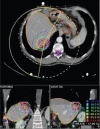Institutional guidelines and ongoing studies in management of liver tumours: the experience of the European Institute of Oncology
- PMID: 22275961
- PMCID: PMC3234063
- DOI: 10.3332/eCMS.2008.64
Institutional guidelines and ongoing studies in management of liver tumours: the experience of the European Institute of Oncology
Abstract
Background: An institutional task force on upper gastrointestinal tumours is active at the European Institute of Oncology (EIO). Members decided to collate the institutional guidelines on management of liver tumours (primary and metastatic) into a document. This article is aimed at presenting the current treatment guidelines as well as ongoing research protocols and trials in this field at the EIO.
Methods: A steering committee convened to assign tasks to individual members. Contributions from experts in each treatment area were collated in a single document, in order to produce a draft for subsequent review from the aforementioned committee. Six drafts have been discussed and the final version approved.
Results: Surgical, medical oncology, interventional radiology, nuclear medicine and radiation therapy approaches, their roles in management of liver tumours and ongoing research trials are presented and discussed in this article.
Conclusions: At the EIO a multi-disciplinary integrated approach to liver tumours is standard and several ongoing research projects are currently active in this field.
Figures















Similar articles
-
Diagnosis and treatment of invasive squamous cell carcinoma of the skin: European consensus-based interdisciplinary guideline.Eur J Cancer. 2015 Sep;51(14):1989-2007. doi: 10.1016/j.ejca.2015.06.110. Epub 2015 Jul 25. Eur J Cancer. 2015. PMID: 26219687 Review.
-
The future of Cochrane Neonatal.Early Hum Dev. 2020 Nov;150:105191. doi: 10.1016/j.earlhumdev.2020.105191. Epub 2020 Sep 12. Early Hum Dev. 2020. PMID: 33036834
-
Diagnostics and Treatment of Thyroid Carcinoma.Endokrynol Pol. 2016;67(1):74-107. doi: 10.5603/EP.2016.0011. Endokrynol Pol. 2016. PMID: 26884119
-
Six Sigma: not for the faint of heart.Radiol Manage. 2003 Mar-Apr;25(2):40-53. Radiol Manage. 2003. PMID: 12800564
-
Principles and guidelines for surgeons--management of symptomatic breast cancer. European Society of Surgical Oncology.Eur J Surg Oncol. 1997 Apr;23(2):101-9. doi: 10.1016/s0748-7983(97)80001-7. Eur J Surg Oncol. 1997. PMID: 9158182 Review.
References
LinkOut - more resources
Full Text Sources
